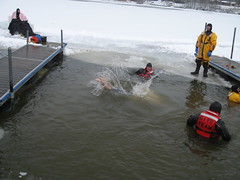I’ll get a better post up with a lot more detail once I’m able to get a little more time. I just didn’t want to keep you in suspense any longer.
Thank you to everyone who was so generous and donated. All told, with online, offline and matching funds, we raised a staggering $3522.11. Overall the event raised a little over $26k. That’s an awesome amount of money and the Special Olympics of Michigan will make it stretch. However, they are not done yet – there are more plunges happening this around Michigan. In fact, a guy who is plunging because of me is Jeremy Lance – you should donate to his plunge at http://www.firstgiving.com/jer_.
In short, here is a short video showing the polar plunge itself.
Again – thank you to everyone who donated!
| Display Name | Date | Amount | Comment |
| brian gorbett | 2/13/2010 | $100.00 | even though i missed the plunge, u r awesome! |
| Rebecca and Paul Foret | 2/13/2010 | $15.00 | |
| Cal evans | 2/13/2010 | $25.00 | |
| Michael Letterle | 2/13/2010 | $25.00 | One of the many reasons you rock |
| Mark Brown | 2/13/2010 | $50.00 | Happy to help for a great cause. Match from MS to get you $100. |
| Susan and Leon Holmes | 2/13/2010 | $25.00 | |
| Brian Genisio | 2/13/2010 | $20.00 | |
| Kevin | 2/12/2010 | $25.00 | |
| Anonymous | 2/12/2010 | $35.00 | Plunge Josh Plunge |
| Vid Luther | 2/12/2010 | $51.00 | |
| James Ward | 2/12/2010 | $50.00 | Burrrr…. |
| Drew Robbins | 2/12/2010 | $50.00 | |
| James Bender | 2/12/2010 | $50.00 | Good luck, that waters cold! |
| Matt Davis | 2/12/2010 | $50.00 | |
| Janet Keller | 2/12/2010 | $50.00 | Hats off to you for that kind of commitment! Will be cheering from the fireside… |
| Sazbean | 2/12/2010 | $50.00 | Brr! Great cause! Get warm with a tasty beverage afterwards! – Sarah & Aaron |
| Clark Sell | 2/12/2010 | $25.00 | Stay Warm |
| Dave Redding | 2/12/2010 | $50.00 | Here’s to the SO. Get a descent camera man this time! |
| Scott Watermasysk | 2/12/2010 | $25.00 | |
| JRPendarvis and family | 2/12/2010 | $20.00 | |
| Jim Holmes | 2/12/2010 | $100.00 | |
| Anonymous | 2/12/2010 | $20.00 | |
| ElizabethN | 2/12/2010 | $10.00 | You rock, Josh! |
| Larry Clarkin | 2/12/2010 | $25.00 | Dive Deep! |
| Anonymous | 2/12/2010 | $20.00 | |
| Shawn S | 2/11/2010 | $20.00 | |
| Scott MacVicar | 2/11/2010 | $100.00 | Video or it didn’t happen |
| Pablo Godel | 2/11/2010 | $50.00 | Good luck! |
| Evan | 2/11/2010 | $50.00 | You must Chill! We have hidden your keys! |
| The Detroit Java User Group | 2/11/2010 | $50.00 | |
| Greg Malcolm | 2/11/2010 | $40.00 | Setting light to the lake first is cheating! |
| Jenn Brees | 2/6/2010 | $20.00 | |
| Anonymous | 2/5/2010 | $25.00 | Every1 has some sort of a special need.Some needs r > others. Thnk u 4 helping me w mine.-code junky |
| see.clay | 2/5/2010 | $190.00 | over the hump, thanks for the chats, some people you remember – for a reason |
| Anonymous | 2/5/2010 | $20.00 | |
| Anonymous | 2/5/2010 | $40.00 | I’ll be thinking “Warm” thoughts for you. |
| Liza Sisler | 2/4/2010 | $100.00 | When you go to Ireland check out the ‘Forty Foot’ for Polar Plunge #2 |
| Nathan Hancock | 2/3/2010 | $100.00 | Have Fun! |
| Dawn | 2/2/2010 | $50.00 | Not dunking you… just pushing you closer to the edge, Jer |
| Greg | 2/2/2010 | $100.00 | I expect to see you guys holding hands when you jump in! |
| Martin L. Shoemaker | 2/2/2010 | $108.11 | You’re a brave man, brother Josh! |
| Chris Large | 2/2/2010 | $20.00 | My pleasure… |
| Matt Cowan | 2/2/2010 | $25.00 | Way to go! |
| Larry Siden | 2/2/2010 | $18.00 | “18” in Hebrew letters spells “life”! |
| Jason Chrispen | 2/2/2010 | $20.00 | Good luck, sounds like a great cause. Make your daughter proud. |
| aunt red | 2/2/2010 | $10.00 | go jeremy, great cause |
| Jacob Mullins | 2/1/2010 | $50.00 | Rock on brother! |
| Rob Allen | 2/1/2010 | $25.00 | |
| Ashwin Karuhatty | 2/1/2010 | $50.00 | I am proud of you! |
| John Gilmour | 2/1/2010 | $25.00 | Cold, cold, cold…. |
| DeVaris Brown | 2/1/2010 | $50.00 | Anything to help out brothaman |
| Tim COrbett | 2/1/2010 | $30.00 | Hope you reach your goal |
| Joe Saul | 1/31/2010 | $50.00 | Josh, I don’t know you, but I’m doing this because of Jer’s co-pledge, so make sure he goes in too! |
| Hawthorne Property Services | 1/31/2010 | $100.00 | |
| Dinah | 1/31/2010 | $5.00 | Wish I could give more. I’ve done the jump and know how much fun it can be 🙂 good luck! |
| Chris and Tracy Woodruff | 1/31/2010 | $25.00 | Way to go Josh!! Stay warm!! |
| Angela Dugan | 1/31/2010 | $100.00 | My hubby does the jump every year, looks like, um, fun? 🙂 |
| Anonymous | 1/31/2010 | $20.00 | Brrrrrr! |
| Sadukie | 1/30/2010 | $25.00 | Here’s to you and your Wonderpuzzle! 🙂 |
| Anonymous | 1/30/2010 | $20.00 | Hey Josh, worked with you once a few years ago, but I too have a daughter with special needs. 🙂 |
| Ryan Weaver | 1/30/2010 | $25.00 | Living and swimming in MI – you make me feel like a traitor 🙂 – love the cause |
| Chris Coneybeer | 1/29/2010 | $35.05 | For a great cause. Go Josh! |
| Donna Bank | 1/29/2010 | $25.00 | This gives new meaning for “COLD CASH” |
| Keith “The Monkey” Casey | 1/29/2010 | $39.95 | I want to see this one on video 🙂 |
| The Coffee Mill Cafe | 2/12/2010 | $100.00 | |
| The Tackets | 2/12/2010 | $25.00 | |
| Anonymous | 2/12/2010 | $100.00 | |
| Matching funds | Over $600 |

 Building on the
Building on the 
![azure[1] azure[1]](https://joshholmes.com/blog/content/binary/WindowsLiveWriter/RunningJoomlaonAzure_BFDC/azure%5B1%5D_thumb.png)




